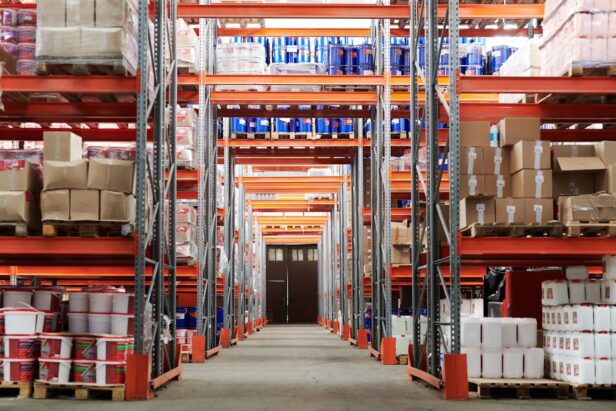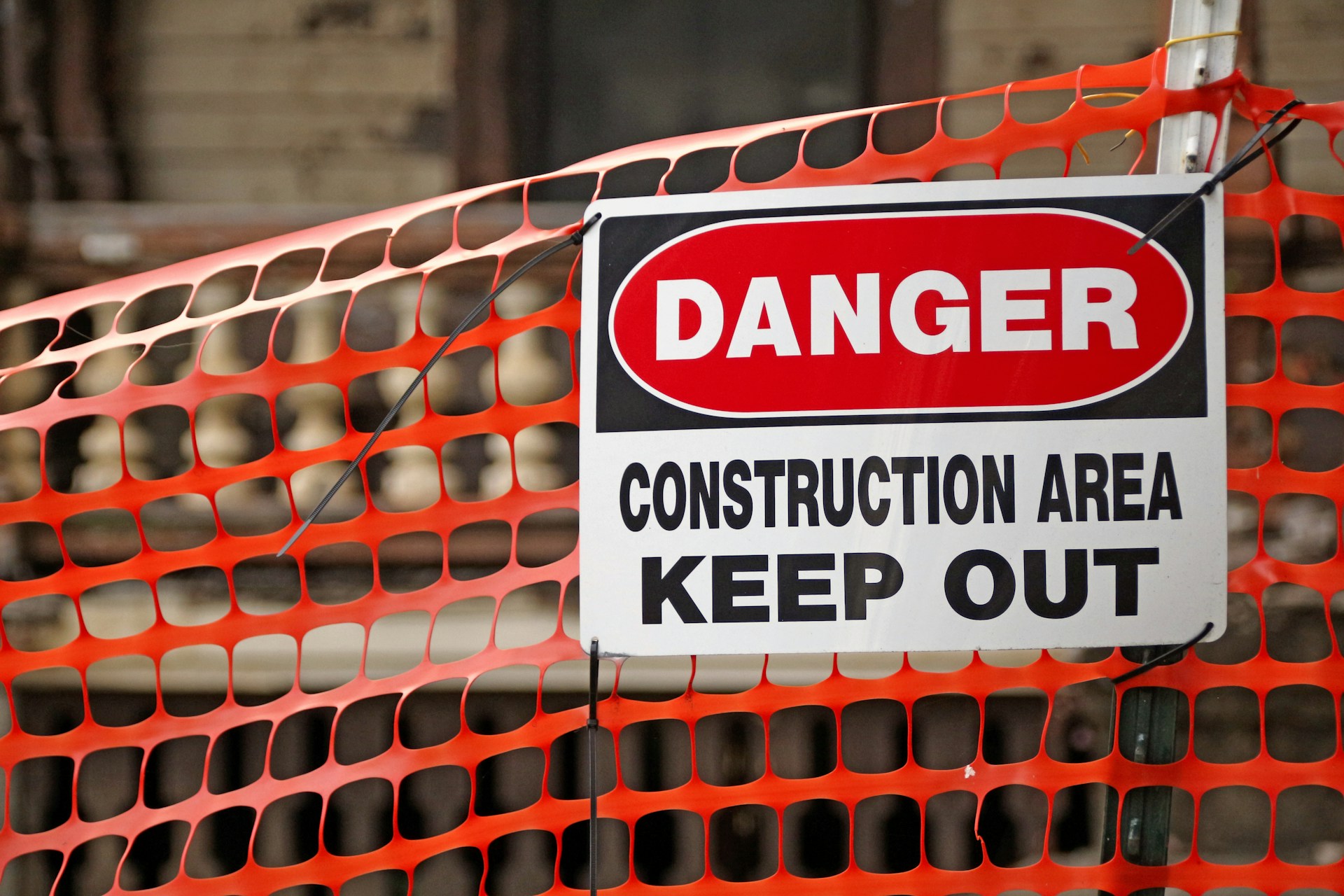An e-commerce fulfillment space is the engine driving online retail operations. At EB3 Construction, we recognize that the physical layout of your warehouse or distribution center directly affects your ability to process orders efficiently and meet customer expectations. A well-designed fulfillment center is more than just its square footage; it’s a strategic asset that can give your business a competitive edge.
When we undertake e-commerce build-outs, our goal is to optimize every square foot for peak performance. This involves carefully considering factors like inventory storage systems, pick and pack stations, and traffic flow. The right layout can significantly reduce order processing times, minimize errors, and scale smoothly as your business grows.
In today’s dynamic e-commerce landscape, customers expect rapid order fulfillment with flawless accuracy. Your physical space must rise to the challenge. By teaming up with EB3 to create a purpose-built e-commerce fulfillment center, you’re laying the foundation for operational excellence and long-term success. Discover how we can transform your space into a high-performance fulfillment machine.
How Should You Plan Your Space Requirements for E-Commerce Fulfillment?
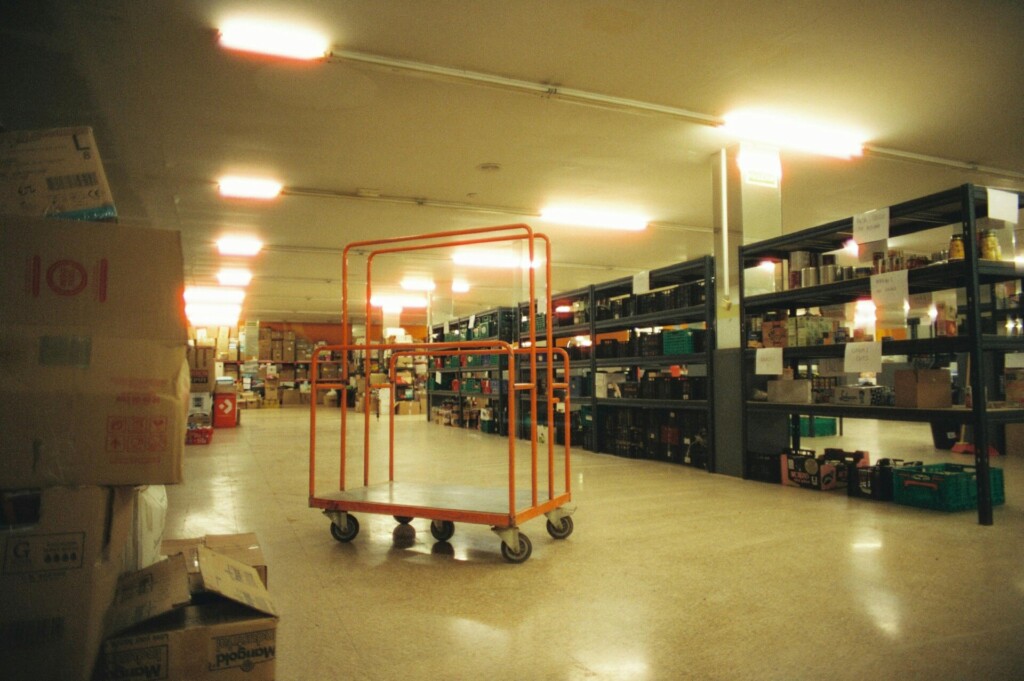
When planning warehouse space for e-commerce fulfillment, consider cubic volume rather than just square footage. The height of your warehouse greatly affects the total usable space, so it’s important to explore vertical storage opportunities. Here’s our approach to space planning for optimal e-commerce fulfillment:
Calculate Total Storage Capacity
Start by determining how many pallets and cartons you need to store. Multiply the footprint of each storage unit by the number of units to get a baseline space requirement. Consider including:
- Pallet dimensions and stacking height limits
- Carton sizes and shelving configurations
- Inventory turnover rates to estimate average stock levels
Allocate Space for Operational Zones
An efficient e-commerce warehouse requires dedicated areas for key processes. We typically allocate space for:
- Receiving – For unloading and processing incoming inventory
- Storage – The main inventory holding area, considering various storage methods
- Picking and Packing – Space for order fulfillment activities
- Shipping – Area for order staging and outbound logistics
The exact proportion of space for each zone depends on your specific operations, but generally:
Plan for Growth and Seasonality
We always advise building in extra capacity to accommodate business growth and seasonal fluctuations. Planning for 10-20% more space than your current needs is a good target. This buffer helps ensure your fulfillment center can scale without major disruptions.
Optimize Vertical Space
Maximize your warehouse’s height by implementing:
- High-bay racking systems
- Mezzanine levels for additional picking or packing areas
- Vertical lift modules or carousels for small parts storage
By maximizing vertical space, storage capacity can often be significantly increased without expanding the warehouse footprint.
Consider Material Handling Equipment
The type of equipment you use impacts space requirements. Factor in:
- Forklift aisle widths
- Reach truck turning radiuses
- Conveyor systems and their footprint
Selecting the right equipment for your space constraints is crucial for optimizing fulfillment efficiency.
By taking this comprehensive approach to space planning, we ensure your e-commerce fulfillment center can handle current inventory needs while allowing room for future growth. Remember, an efficiently planned warehouse layout is key to streamlining operations and meeting customer expectations for fast, accurate order fulfillment.
How Can You Optimize Traffic Flow in Your Fulfillment Center?
Efficient traffic flow is crucial for maximizing productivity and safety in our e-commerce fulfillment centers. By strategically designing movement patterns and implementing smart picking methods, we can considerably reduce congestion and enhance order processing speeds.
One of our key strategies involves creating designated walkways with multiple lanes to facilitate smooth employee movement in various directions. We carefully analyze traffic patterns and establish clear paths that minimize intersections and bottlenecks. This approach allows team members to navigate the warehouse quickly and safely, even during peak periods.
Choosing the right picking method also plays a significant role in optimizing traffic flow. We evaluate factors such as SKU count, order volume, and inventory characteristics to determine the most efficient approach:
- Piece picking for operations with lower SKU counts and order volumes
- Batch picking to consolidate multiple orders and reduce travel time
- Zone picking to divide the warehouse into sections for specialized picking
- Wave picking to coordinate picking and shipping schedules
Our warehouse management system (WMS) plays a crucial role in traffic optimization. It analyzes real-time inventory data and order information to generate intelligent pick paths. This ensures our team takes the most efficient routes through the warehouse, minimizing unnecessary movement and maximizing productivity.
We also conduct regular studies of product demand and placement. Fast-moving items are strategically positioned for easy access, further streamlining the picking process and reducing traffic in less frequently accessed areas.
By focusing on these traffic flow strategies, we significantly enhance our fulfillment speed, improve worker safety, and boost overall operational efficiency. The result is a smoother, more productive warehouse environment that allows us to meet the demanding expectations of modern e-commerce.
What’s the Best Approach to Product Location and Storage Organization?
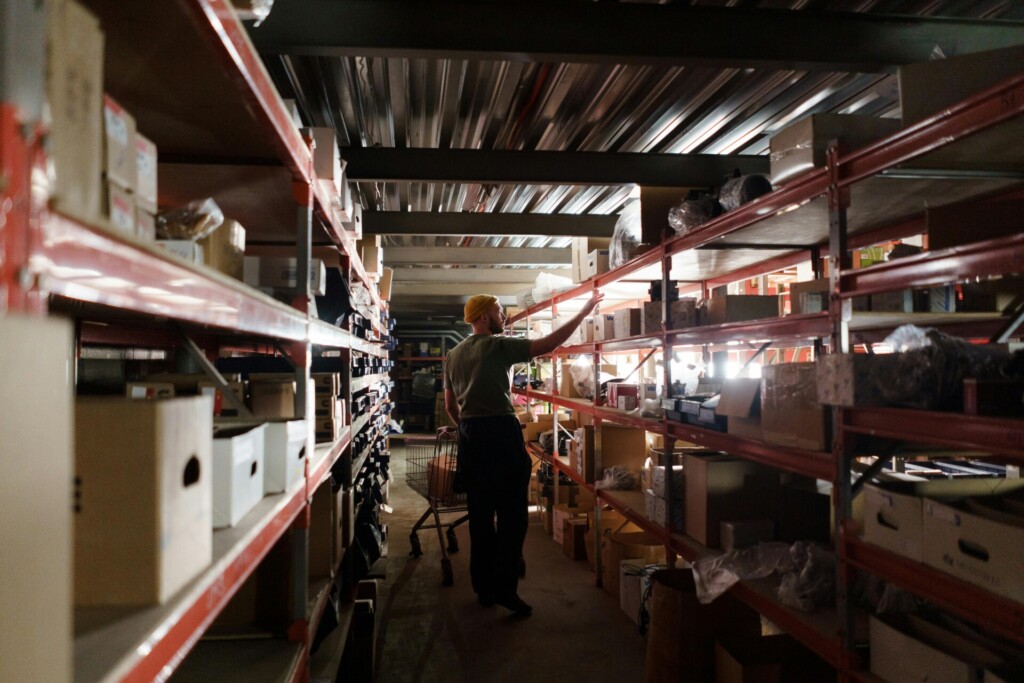
Strategic product placement is crucial for maximizing fulfillment speed and operational efficiency in the warehouse. At EB3 Construction, we recommend letting your picking method drive storage decisions. For instance, zone picking works well when similar product types are grouped together, allowing pickers to work efficiently within designated areas.
We advise placing popular items and frequently purchased combinations in easily accessible locations to minimize travel time and reduce worker fatigue. This could mean positioning best-sellers near packing stations or storing commonly bundled products adjacently. Even small tweaks to item locations can yield significant time savings when multiplied across hundreds of daily picks.
For larger operations, we often implement automated storage and retrieval systems (ASRS) to rapidly locate and retrieve items. These systems can dramatically accelerate picking while improving accuracy. However, they require careful planning and integration with existing warehouse management software.
It’s important to remember that optimal warehouse organization is an ongoing process, not a one-time effort. We work with clients to regularly review and refine their layouts, accounting for seasonal inventory shifts and evolving product demand patterns. This continual optimization ensures the warehouse layout remains aligned with current operational needs.
When redesigning storage areas, we consider factors like product dimensions, turnover rates, and handling requirements. Bulky or heavy items may need ground-level placement, while small, fast-moving SKUs could be ideal for mezzanine storage. The goal is to create an intuitive flow that boosts picker productivity and minimizes unnecessary movement.
Ultimately, effective product location and storage organization directly impact your bottom line. By thoughtfully arranging inventory and leveraging automation where appropriate, we help warehouses significantly reduce labor costs while improving order fulfillment speed and accuracy. This strategic approach to space utilization can be a key differentiator in today’s competitive logistics landscape.
How Can Technology Enhance Your E-Commerce Fulfillment Space?
Integrating technology is essential for optimizing contemporary e-commerce fulfillment operations. We implement robust Warehouse Management Systems (WMS) to digitally track inventory, manage orders, and streamline material movement throughout the fulfillment process. Our WMS solutions provide real-time inventory visibility with automated alerts and predictive stock availability views, enabling us to manage inventory levels proactively and avoid stockouts.
To create a seamless omnichannel experience, we integrate e-commerce platforms directly with our WMS. This provides immediate access to current stock levels and order status across all sales channels. For high-volume operations, we leverage automation technologies like barcode scanning, RFID tracking, and automated picking systems to significantly improve accuracy and throughput.
When selecting fulfillment technologies, we focus on solutions that directly enhance the customer experience through faster, more accurate order processing. For example, barcode scanning and RFID tracking allow us to locate and pick items quickly while minimizing errors. Automated sorting systems help us efficiently route orders to the correct packing stations, and integrated shipping software enables us to compare carrier rates in real-time to optimize delivery speed and cost.
While automation can deliver significant efficiency gains, we take a measured approach to implementation. We analyze current processes, order volumes, and SKU profiles to determine which technologies will provide the best return on investment for each unique fulfillment operation. This ensures we deploy the right mix of manual and automated systems to maximize productivity without over-investing in unnecessary equipment.
Ultimately, our goal is to leverage technology to create a flexible, scalable fulfillment infrastructure that can adapt quickly to changing business needs and customer expectations. With the right systems in place, we’re able to handle higher order volumes, expand into new sales channels, and provide the fast, accurate fulfillment that today’s e-commerce customers demand.
| Technology | Description | Benefits |
|---|---|---|
| Automation and Robotics | Automated systems such as robots and conveyor belts used in various fulfillment stages. | Improve speed, accuracy, and worker safety. |
| Inventory Management Systems | Software for tracking and managing inventory levels and stock locations. | Provides real-time stock visibility, reduces stockouts and overstocks. |
| Order Management Systems | Streamlines order processing, from receiving to fulfillment. | Ensures accurate, timely fulfillment and improves efficiencies. |
| Warehouse Management Systems | Optimize warehouse operations like picking routes and space usage. | Enhances order accuracy and fulfillment speed. |
| Shipping and Tracking Solutions | Integrate with carriers to automate package tracking and notification. | Improves delivery reliability and provides real-time tracking information to customers. |
Conclusion: Creating a Flexible, Future-Proof E-Commerce Fulfillment Space
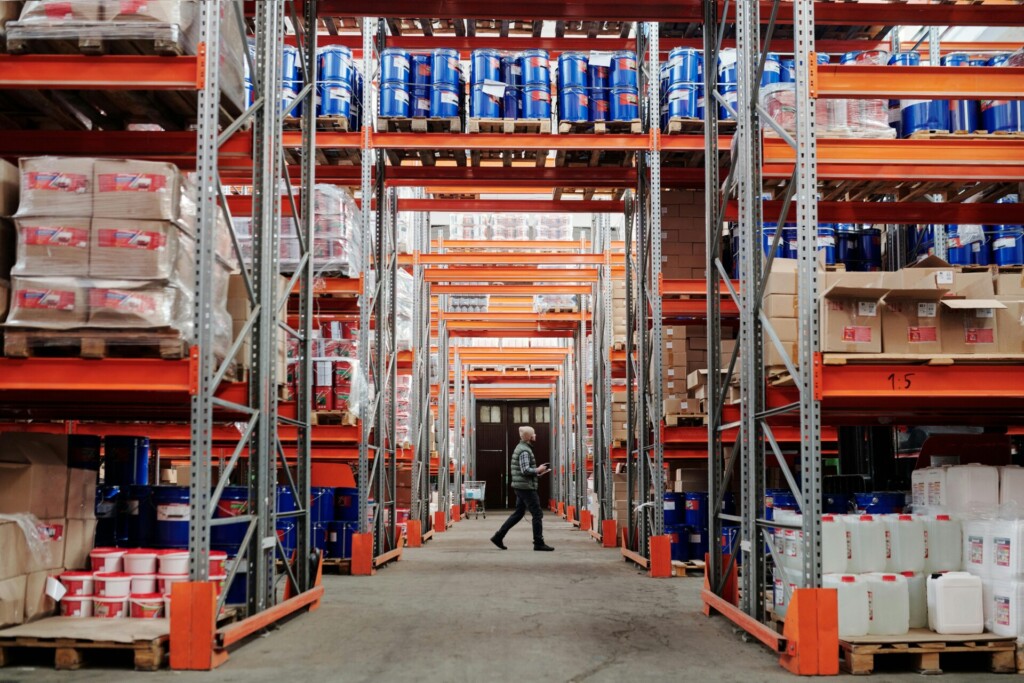
Successfully building an e-commerce fulfillment space requires careful planning of space requirements, traffic flow, product organization, and technology integration. At EB3 Construction, we understand a well-organized warehouse isn’t a ‘set it and forget it’ solution. Regular reviews and adjustments are crucial for maintaining efficiency as your business evolves. By creating a flexible, adaptable fulfillment center, you’ll be better equipped to handle growth, seasonal fluctuations, and changing customer expectations.
Our experience shows that investing time in thorough planning now pays dividends in developing a fulfillment operation that will sustain your e-commerce business for years to come. We recommend conducting quarterly assessments of your layout and workflows to identify opportunities for improvement. This may involve reconfiguring picking zones to accommodate new product lines, upgrading conveyor systems to boost throughput during peak periods, or implementing AI-powered inventory management tools to optimize stock levels.
It’s important to remember the e-commerce landscape is constantly changing. What works today may need to be adapted tomorrow as consumer behaviors and technologies evolve. Partnering with an experienced general contractor like EB3 allows you to create a fulfillment space that can grow and change alongside your business. We’ll work closely with you to understand your unique operational needs and design a space that can scale efficiently.
Don’t let an inflexible fulfillment center hold your e-commerce business back. Invest in creating an agile, future-proof space that will empower your success for years to come. Contact EB3 Construction today to discuss how we can help optimize your e-commerce fulfillment operations.

